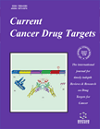- Home
- A-Z Publications
- Current Cancer Drug Targets
- Previous Issues
- Volume 10, Issue 3, 2010
Current Cancer Drug Targets - Volume 10, Issue 3, 2010
Volume 10, Issue 3, 2010
-
-
Epithelial Mesenchymal Transition and Cancer Stem Cell-Like Phenotypes Facilitate Chemoresistance in Recurrent Ovarian Cancer
More LessAuthors: N. Ahmed, K. Abubaker, J. Findlay and M. QuinnOvercoming intrinsic and acquired chemoresistance is the major challenge in treating ovarian cancer patients. Initially nearly 75% of ovarian cancer patients respond favourably to chemotherapy, but subsequently the majority gain acquired resistance resulting in recurrence, cancer dissemination and death. This review summarizes recent advances in our understanding of the cellular origin and the molecular mechan Read More
-
-
-
In Vivo Inhibition of the Estrogen Sulfatase Enzyme and Growth of DMBA-Induced Mammary Tumors by Melatonin
More LessMelatonin inhibits the growth of different kinds of neoplasias, especially breast cancer, by interacting with estrogen- responsive pathways, thus behaving as an antiestrogenic hormone. Recently, we described that melatonin reduces sulfatase expression and activity in MCF-7 human breast cancer cells, thus modulating the local estrogen biosynthesis. In this study, to investigate the in vivo sulfatase-inhibitory properties of me Read More
-
-
-
CD147/EMMPRIN and CD44 are Potential Therapeutic Targets for Metastatic Prostate Cancer
More LessAuthors: J.L. Hao, P.J. Cozzi, A. Khatri, C.A. Power and Y. LiProstate cancer (CaP) is a major health problem in males in Western countries. Current therapeutic approaches are limited and many patients die of secondary disease (metastases). There is no cure for metastatic castration-resistant prostate cancer (CRPC). Targeting tumor-associated antigens is fast emerging as an area of promise to treat late stage and recurrent CaP. Extracellular matrix metalloproteinase inducer, E Read More
-
-
-
Persistent P21Cip1 Induction Mediates G1 Cell Cycle Arrest by Methylseleninic Acid in DU145 Prostate Cancer Cells
More LessThe induction of G1 cell cycle arrest and apoptosis by second-generation selenium compounds (e.g., methylselenol precursors such as methylseleninic acid, MSeA) may contribute to their anti-cancer activities. We have documented previously induction of G1 arrest and apoptosis by MSeA in association with upregulation of cyclin-dependent kinase inhibitor (CDKI) proteins P21Cip1 and/or P27Kip1 in DU145 prostate ca Read More
-
-
-
Reactivation of p53 by Novel MDM2 Inhibitors: Implications for Pancreatic Cancer Therapy
More LessAuthors: A.S. Azmi, P.A. Philip, A. Aboukameel, Z. Wang, S. Banerjee, S.F. Zafar, A.-S. Goustin, K. Almhanna, D. Yang, F.H. Sarkar and R.M. MohammadThe present study is the first to show in pancreatic cancer (PC) the growth inhibition and apoptosis by novel MDM2 inhibitors (MI-319 & 219) through reactivation of p53 pathway. Our results highlight two new secondary targets of MDM2 inhibitor ‘SIRT1’ and Ku70. SIRT1 has a role in ageing and cancer and is known to regulate p53 signaling through acetylation. Ku70 is a key component of non-homologous end joining machinery i Read More
-
-
-
Inhibition of c-Met with the Specific Small Molecule Tyrosine Kinase Inhibitor SU11274 Decreases Growth and Metastasis Formation of Experimental Human Melanoma
More LessAuthors: I. Kenessey, M. Keszthelyi, Z. Kramer, J. Berta, A. Adam, J. Dobos, M. Mildner, B. Flachner, S. Cseh, G. Barna, B. Szokol, L. Orfi, G. Keri, B. Dome, W. Klepetko, J. Timar and J. TovariThe hepatocyte growth factor/scatter factor (HGF/SF) tyrosine kinase (TK) receptor c-Met plays a crucial role in the development of the invasive phenotype of tumors and thus represents an attractive candidate for targeted therapies in a variety of malignancies, including human malignant melanoma (MM). In contrast to what has been shown previously, we were not able to detect any genetic alterations, either in the juxtam Read More
-
-
-
A Novel Cancer Targeting Approach Based on Estrone Anchored Stealth Liposome for Site-Specific Breast Cancer Therapy
More LessAuthors: S.R. Paliwal, R. Paliwal, N. Mishra, A. Mehta and S.P. VyasWe here report the successful utilization of estrogen receptor (ER) for the delivery of anticancer drug doxorubicin (DOX) encapsulated within pegylated liposome for the treatment of breast cancer. Estrone (ES) was anchored as ligand on to stealth liposome (ES-SL-DOX) for targeting to ERs. In vitro cytotoxicity study was conducted on ER positive and negative breast carcinoma cells. The fluorescent microscopy studies w Read More
-
Volumes & issues
-
Volume 25 (2025)
-
Volume 24 (2024)
-
Volume 23 (2023)
-
Volume 22 (2022)
-
Volume 21 (2021)
-
Volume 20 (2020)
-
Volume 19 (2019)
-
Volume 18 (2018)
-
Volume 17 (2017)
-
Volume 16 (2016)
-
Volume 15 (2015)
-
Volume 14 (2014)
-
Volume 13 (2013)
-
Volume 12 (2012)
-
Volume 11 (2011)
-
Volume 10 (2010)
-
Volume 9 (2009)
-
Volume 8 (2008)
-
Volume 7 (2007)
-
Volume 6 (2006)
-
Volume 5 (2005)
-
Volume 4 (2004)
-
Volume 3 (2003)
-
Volume 2 (2002)
-
Volume 1 (2001)
Most Read This Month
Article
content/journals/ccdt
Journal
10
5
false
en


